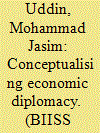|
|
|
Sort Order |
|
|
|
Items / Page
|
|
|
|
|
|
|
| Srl | Item |
| 1 |
ID:
142743


|
|
|
|
|
| Summary/Abstract |
Conceptualisation of economic diplomacy is not a straightforward task as its boundaries involve actors, issues and contents, instruments and levels of, and states (with/by) practicing economic diplomacy. Economic diplomacy concerns how a state undertakes its national policy, how it negotiates and works with different states on the policy at multiple levels and how interaction between the two is administered. Although non-state actors now-a-days are influential, states are central to economic diplomacy that refers to interactions on trade and economy at multiple levels. Thus, economic diplomacy is more than an approach or a model that promotes a state’s economic security. This paper substantiates the argument that responsibilities of actors, countries with whom actors are to negotiate, issues at various levels and instruments employed by actors to facilitate the issues in their favour are vital for a country’s economic diplomacy. Hence, the paper aims at offering a comprehensive summary of issues relevant to conceptualise economic diplomacy.
|
|
|
|
|
|
|
|
|
|
|
|
|
|
|
|
| 2 |
ID:
142741


|
|
|
|
|
| Summary/Abstract |
Export diversification helps a country to increase export earnings and create employment opportunities, especially in labour-intensive export sectors. Product and geographical diversifications are believed to be associated with reduced volatility in export earnings and vulnerability to sharp declines in terms of trade in developing countries. Bangladesh has witnessed remarkable export growth over the last two decades. However, despite policy indicatives for diversification, exports are overly dependent on readymade garments and concentrated to European Union and North American markets. Given this backdrop, the present paper tries to derive empirical evidence on whether the level of export diversification has positive linkage with export growth in Bangladesh. In doing so, it adopts time series econometric techniques to estimate an export supply function. The empirical results reveal that even though export diversification has positive but statistically insignificant linkage with quantity of export supplied in the world market, Bangladesh should pursue the ongoing policy measures to realise statistically significant benefits of export diversification in the long run.
|
|
|
|
|
|
|
|
|
|
|
|
|
|
|
|
| 3 |
ID:
142744


|
|
|
|
|
| Summary/Abstract |
Global climate change in recent years has turned into a complex phenomenon. The issue has drawn widespread attention globally. South Asia is a region which occupies about 5 percent of the world’s total landmass and 20 percent of the world’s total population which is expected to rise about 25 percent by 2025. Over the years, South Asian countries are becoming affected with multitude of climate related hazards including cyclones, floods, droughts, extreme temperatures, glacial lake outburst floods (GLOFs) and storm surges. Climate does not maintain national boundary, therefore, combined efforts are essential to mitigate such calamities. Regional arrangements are considered essential to face climate change challenges. This paper examines initiatives of South Asian Association for Regional Cooperation (SAARC) on climate change issue and tries to recommend what further steps the organisation can adopt in this regard. Although SAARC has taken some initiatives, more concrete and coordinated actions are necessary to face the calamities of climate change.
|
|
|
|
|
|
|
|
|
|
|
|
|
|
|
|
| 4 |
ID:
142742


|
|
|
|
|
| Summary/Abstract |
South Asia as a region has been facing the challenges of transnational terrorism and extremism – be it religious fundamentalism, separatist or left-wing – for more than three decades. The irony, however, is that escalation of terrorism in South Asia along with its political division has made it easier-said-than-done to have meaningful regional collaboration on the issue. The purpose of this paper is to find out the factors, which hinder effective counter-terrorism cooperation in South Asia. Based on the “Regional Security Complex Theory (RSCT)”, this paper argues that the security structure in South Asia is uniquely characterised by historical mistrust among its members, specially its bipolar conflictual power structure. It further argues that the nature of conflict formation in South Asia has facilitated the rise and sustenance of transnational terrorism. Finally, it contends that extreme reliance on the zero-sum notion of security by South Asian states prevents the South Asian Association for Regional Cooperation (SAARC) to emerge as an effective counter-terrorism organisation on a regional basis.
|
|
|
|
|
|
|
|
|
|
|
|
|
|
|
|
| 5 |
ID:
142745


|
|
|
|
|
| Summary/Abstract |
This paper takes an attempt to analyse the Motor Vehicle Agreement (MVA) among four South Asian nations namely Bangladesh, Bhutan, India and Nepal (BBIN) signed on 15 June 2015 to ensure cross border movement of personal, passenger and cargo vehicles. The paper argues that in spite of having several implementation challenges, this MVA paves the way to much needed multimodal transport connectivity among South Asian countries to foster rapid and sustainable economic growth and development through inter-and-intra-regional cooperation.
|
|
|
|
|
|
|
|
|
|
|
|
|
|
|
|
|
|
|
|
|